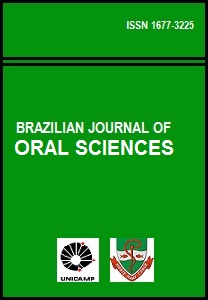Abstract
Aim: Cone beam computed tomography (CBCT) was used to evaluate the ability of three NiTi rotary systems to maintain the original root canal anatomy. Methods: Sixty mesiobuccal canals of human mandibular first molars were divided into three groups with 20 root canals each. All teeth were scanned by CBCT before instrumentation. The images were captured digitally for further analysis using the Image Tools Software. The images were sectioned in three points, located at 9 mm, 6 mm and 3mm from the apex. In Group 1, the root canals were instrumented with ProTaper Universal™ rotary system; in Group 2, with Twisted File™ rotary system; and in Group 3, with Mtwo™ rotary system. Instrumented teeth were scanned again using CBCT and the images of the uninstrumented canals were compared with images of the instrumented canals. The results were statistically analyzed using the one-way ANOVA test. A level of significance of 0.05 was adopted. Results: The means of D1 at distances of 9 mm, 6 mm, and 3 mm from the apex were, respectively: Group 1: 0.88±0.257, 1.00±0.000, and 1.00±0.000; Group 2: 0.79±0.745, 0.65±0.669, and 0.25±0; Group 3: 0.50±0.745, 0.33±0.472, and 0.03±0.104. The means of D2 at distances of 9 mm, 6mm, and 3mm from the apex were respectively: Group 1: 1.00±0.00, 1.00±0.00, and 1.00±0.00; Group 2: 0.41±0.299, 0.30±0.428, and 0.50±0.707; Group 3: 0.58±0.910, 0.85±1.857, and 0.31±0.643. Conclusions: The CBCT analysis revealed that the ProTaper Universal™ produced centered preparations and while the Twisted File™ and Mtwo™ rotary systems produced canal deviation.
This work is licensed under a Creative Commons Attribution 4.0 International License.
Copyright (c) 2015 Carlos Menezes Aguiar, Fernanda Araujo Donida, Andréa Cruz Câmara, Marco Frazão
Downloads
Download data is not yet available.

